Yellow-legged Asian hornet
Vespa velutina
The Yellow-legged Asian hornet is an alien species that has entered the UK on several occasions and represents a threat to honeybees.
Your committee takes the view that ALL members should acquaint themselves with the risks and possible dangers posed by yellow-legged Asian hornets as well as the way forward if we are invaded.
East Devon Asian Hornet coordinator – Kevin Jackson
Email: ahatcoordinator@edbk.co.uk
Check out the BBKA Asian hornet page to help the fight against the Asian hornet invasion.
If you spot a Yellow-Legged Asian Hornet or a nest please report it immediately.
It is crucial that possible sightings are reported so experts can take quick and effective action to eradicate Yellow-Legged Asian Hornets. Please include an image wherever possible as written descriptions are much less effective. Without an image, sightings are much less likely to be followed up.
‘Asian hornet Watch’ App

The best way to report any sightings is by using the free ‘Asian Hornet Watch‘ App, available to download below. The App allows users to check similar species and report a sighting. A photo is requested as key to identification. Date and location are automatically completed and brief comments can be included. A reminder about personal safety is also included. Reporting can lead to investigation and nest destruction which is essential for eradication.
Photos and videos can be emailed to: alertnonnative@ceh.ac.uk. Please ensure you include a location and contact details. A ‘What 3 Words’ location would be ideal.
Online form
Use this link to access the online Reporting Form. Please include a photo, if possible.
Identification
These images show the essential features for identification. The most likely mis-identification is with Vespa crabro, our European hornet.

Asian hornet
Note the yellow legs and the single broad yellow band near the tail.*
Asian hornet
The features shown will easily distinguish the Asian from the European hornet.*
European hornet
Vespa crabro. Distinctive yellow abdomen.*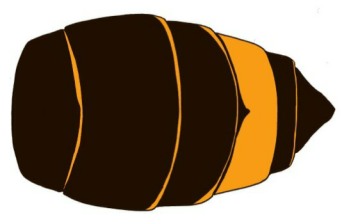
Asian hornet abdomen
Note the broad yellow band near the tail.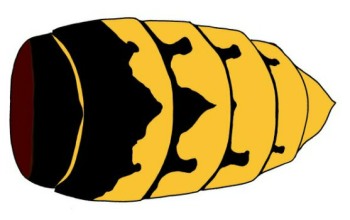
European hornet abdomen
The European hornet is slightly longer than the Asian hornet.
Wasps
Wasps have similar yellow and black markings to the European hornet.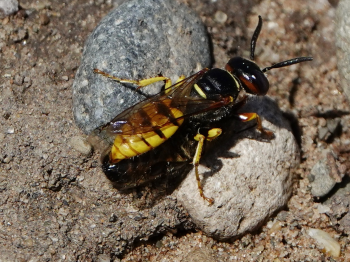
Beewolf
This beewolf is carrying honeybee prey. Abdomen yellower than Asian hornet.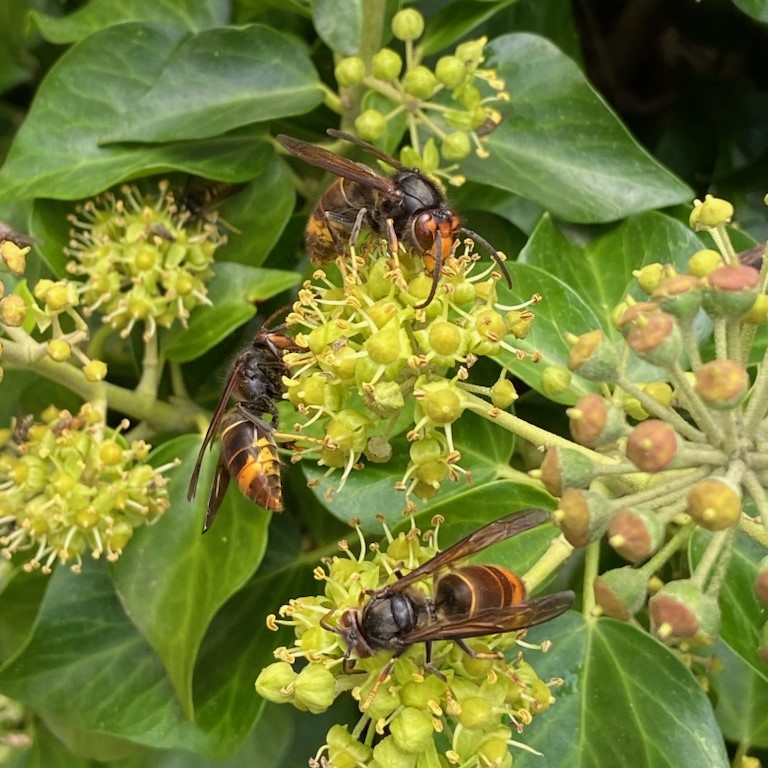
Asian hornet on ivy
*Images courtesy The Animal and Plant Health Agency (APHA), Crown Copyright
Essential reading for identification.
Asian hornet poster issued by the GB non-native species secretarial (NNSS).
Asian hornet alert, also issued by NNSS.
Background information and links to helpful sites
Understanding the life cycle of the Asian hornet is essential for our eventual control of this predator. A brief guide is given after this section.
The GB non-native species secretariat website has a species information sheet specifically for the Asian hornet.
The Devon Beekeepers’ Association website has information on identification, obtaining a sample, Guidance Protocols for beekeepers and branches plus all the links for sample submission.
The ‘Jersey Method’ of hornet tracking and nest location was developed in Jersey when the yellow-legged Asian hornet first arrived there (France is only six miles away). Click the link for a brief description of the method and equipment used.
Life Cycle
Professor Stephen Martin at University of Salford has recently published a book called The Asian Hornet – Threats, Biology & Expansion. Here are some of the observations of an expert who has been studying hornets since 1987.
The life cycle is similar to wasps and bumble bees. Queen hornets mate in the autumn and hibernate in a safe niche protected from rain, snow and wind. During hibernation queens fold their wings under their abdomen, pressed against their body, giving them a distinctive appearance. The queens will come out of hibernation as the weather warms.
The queen’s fat reserves will be low so she seeks nectar and tree resin to activate her ovaries and sustain nest building activities. During the next few weeks she hunts for a suitable nest site, usually enclosed and protected, then begins the building process using wood fibres. The nest hangs down and is attached to the substrate at the top by a stalk or petiole. The lower end of the stalk forms the hexagonal cells for brood rearing. They hang down with the open end at the bottom. The entire structure is surrounded by a thin wood fibre (paper) envelope and at this stage may be 4 -5cm across.
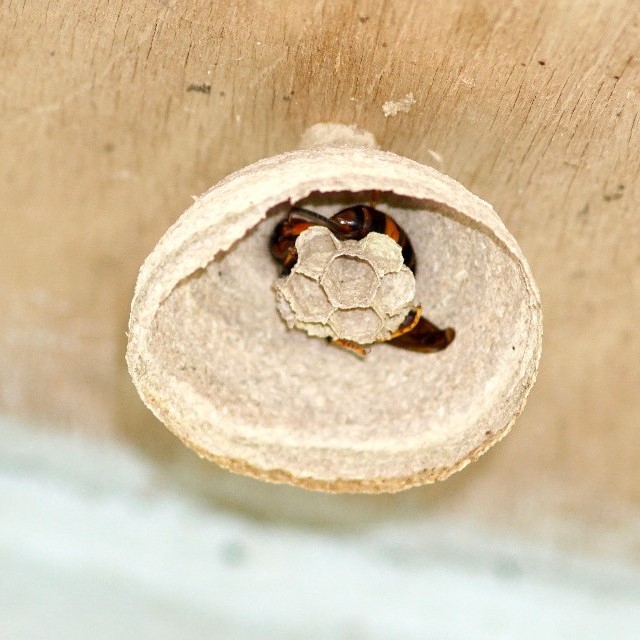 Beginning of proto-nest
Beginning of proto-nest
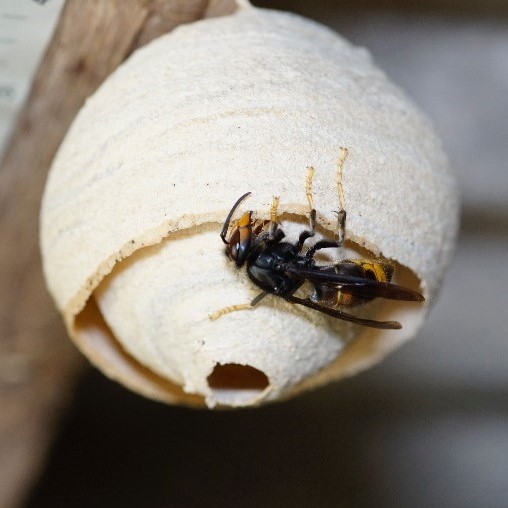 Proto-nest
Proto-nest
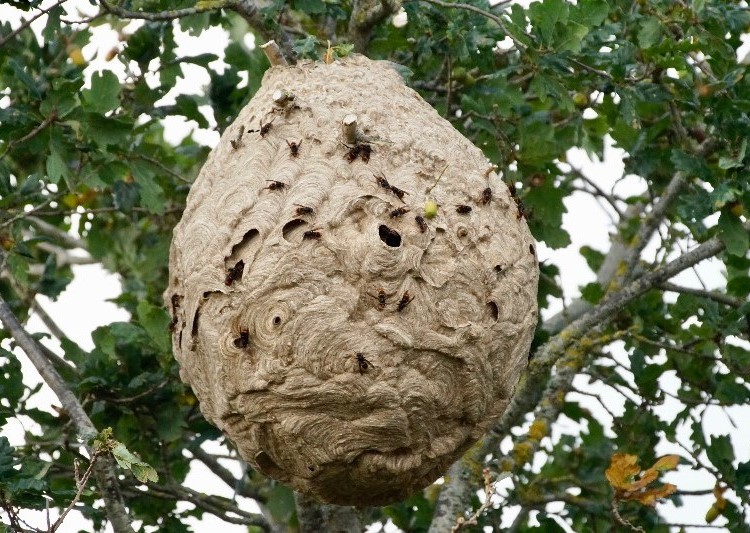 Secondary nest
Secondary nest
All images Courtesy The Animal and Plant Health Agency (APHA), Crown Copyright
When this proto-nest is finished the queen lays an egg at the base of each cell attached to the cell wall by an adhesive. Hatching in 3 to 4 days the larva initially remains attached to the old egg case to prevent falling out of the cell. Eventually the larva grows big enough to fill the whole cell, spins a silken cocoon and pupates. It takes about 50 days for the lone queen to build the proto-nest and at this stage the time from egg to adult worker may take 50 days as the nest is too small to thermoregulate.
When the first workers appear there is a short ‘co-operative’ period around June when both workers and queen are active outside the nest. As the colony numbers increase, the queen stays in the nest and becomes the egg layer.
June to August sees rapid expansion in nest size and colony numbers and if the original location is too small the whole colony may re-locate to a more suitable site, in a tree or under the eaves of a tall building. This process may only take a few days.
During the ‘reproductive phase’ (September to October) the nest is large enough to thermoregulate at around 30°C and the time from egg to adult reduces to 29 days. Some larger cells will be created for the queen to lay unfertilised eggs that will become drones and fertilised eggs that will be queens. Numbers of queen and drone hornet produced vary considerably, largely dependent on climatic conditions. 300 queens and 600 drones are possible but with favourable conditions these numbers could treble!
These ‘sexuals’ stay in the nest for a week or so building up their fat reserves then leave the nest without an orienting flight as they will not return. After mating, the fertilised queen seeks a safe place to hibernate, the drones die and the nest goes into decline. The whole Asian hornet cycle takes 8 – 10 months compared to 5 -6 months for the European hornet.
How to protect your bees
Professor Martin argues that the only proven method of hornet control is colony discovery and destruction. Neither task is easy. The advice given in the book is to call in the professionals! Never attempt to remove or kill an Asian hornet nest yourself. If things go wrong you put yourself and others in grave danger, even of being killed as has happened in France. We have a long way to go before an effective strategy emerges to protect our bees and the public from this very successful alien species.
See the Library page for details of:
The Asian Hornet – Threats, Biology & Expansion by Dr Stephen Martin.
The Asian Hornet Handbook by Dr Sarah Bunker of Okehampton branch.
The Jersey Method of hornet tracking and nest location

What can beekeepers do?
- Monitor with Trappit bait, and report to NBU. (Members can obtain Trappit from EDBK AH Team).
- Take opportunities to engage with the public. Encourage them to keep a look out and report.
- Act as verifiers.
- If you are able, help with tracking if needed.
Where and When to Monitor
Choose the best place that requires the least effort, and reduces or eliminates unwanted effects of monitoring (bycatch).

Most members will be monitoring in a Green Zone using bait stations which do NOT cause problems with bycatch. Jersey AH monitoring teams often use the simple jar with a hole in the lid and a wick to disperse the bait odour. See image bottom left.

Phases of monitoring change with the life cycle, so early in the year the overwintered queens will emerge, feed and migrate somewhere near the old nest. Later, the queen and colony will be in a static nest, which could be anywhere. Early in the year there is a low chance of monitoring being successful but if hornets are identified, then nests are easier to see. Later monitoring has a higher chance of success, but by then nests will be almost invisible due to leaf cover. The compromise time is late May to early June, and again in August and September. What about July? Apparently, the colony will be busy water gathering to create the secondary nest, so are less likely to be attracted by bait stations.
The NBU will be trapping around previous sites to catch new queens. Beekeepers can carry out intermittent monitoring with open bait wherever and whenever they have time to watch the bait station.
Asian Hornet Tracking Method, as developed on Jersey
When Asian hornets have been sighted, there are Five steps:
- Place bait station.
- Watch direction of flight to the nest and record it on a map.
- Judge the distance to the nest.
- Place further bait stations.
- Close in on the nest.
What you will need:
Compass
Timer
Notebook
Map print out
Also good to have:
Binoculars
Two-way radio
- Step 1 – Place the bait somewhere the odour of the bait will disperse widely e.g., on a bucket or fence post.
- Step 2 – Observe the direction of flight. Note where you lose sight, and check a matching point on the horizon. Check several flights, and when reasonably consistent, take the central point. Measure this direction with your compass and transfer the direction from the compass onto the map. Satellite view on Google Earth is ideal. Draw the direction line from your location on the map.

- Step 3 – Judge the distance to the nest by measuring the time it takes for a marked hornet to leave and return. Using a timer is easier than using a phone. Every minute of absence means the nest is another 100 metres away. It is often less than 5 minutes in practice.
Hornets fly by visible landmarks so may not fly from the bait directly towards the nest. However, as a marked hornet learns the route, it will start to cut corners and make your results more accurate. Record each return time. These should be quicker as the hornet learns the route. Choose the LOWEST consistent time for your final result.
If hornets return in less than 2 minutes the nest may be closer than you think. This is because they will take time to gain altitude from bait stations near the base of a tree. Unloading time in the nest is usually about half a minute. - Step 4 – Place further bait stations. This may just be a question of moving closer along your compass bearing or you may set up more stations to triangulate, if you can do so without trespassing.

- Step 5 – Close in on the nest. Wait until the return times are less than 2 minutes or when you have three flight paths crossing at one point. Remember that nests are difficult to see in tall trees, so look for skyline ‘traffic’ instead. When nests are in hedges or brambles, stay away. You can hand over to the NBU team at any stage.
Hand over to NBU
Contact the NBU with a clear description of the site, mark the tree/bush etc and preferably give a What 3 Words address. If you suspect a low nest, take precautions to keep the public away.
How to mark without capture
Technically, it is illegal to capture an alien species and then release it after marking. However, it is possible to mark a hornet, without capture, at a bait station using a Posca pen, as used for marking queen bees. It may require practice!
Further information
New BBKA guide to trapping. Download the PDF file: AH Monitoring Trapping Guidance Leaflet v1 2024.pdf

